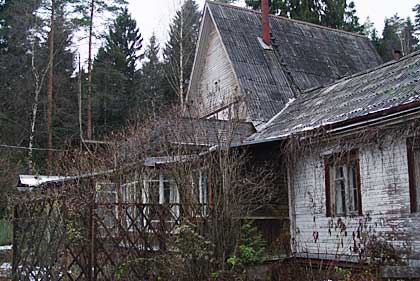
The Dacha: Russia’s Retreat, Soul Saver and Key Food Supplier
Publication: Eurasia Daily Monitor Volume: 6 Issue: 132
By:

The Russian word "dacha" loosely means "country house." The dacha concept, however, is much broader than that. It personifies both the Russian way of life, and the Russian dream, if there ever was one. Dachas come in different shapes and sizes, ranging from summer wooden shacks with outhouses, built wall to wall on tiny plots of one seventh of an acre, to red-brick multi-storied palaces, separated by hectares of wooded parkland and lakes. They adorn -or disfigure- the Russian vistas from Smolensk to Vladivostok.
It was at their dachas in the nineteenth century that the Chekhovian intelligentsia lamented their misguided lives and the imperfections of human nature. It is at the dachas behind the customary green FSB-guarded fences, rather than in parliament or the cabinet, that all the major political decisions are made. It is to the dacha that teenagers escape from their parents with girl or boyfriends, or parents escape from their teenage children.
Indeed, it is the dacha that keeps Russians fed during the country’s perennial crises -and curiously serves as the major indicator of the current state of the economic crisis. "The more potatoes people grow at their dachas, the worse things are becoming in Russia," Andrei Tumanov, editor of Vashi 6 Sotok ("Your 600 Square Meters," Russia’s most popular gardening magazine) told Moscow’s TV 3 channel on May 16. "That is a law of statistics," he continued.
Tumanov explained that the sales of vegetable seeds had increased by 40 percent from last year, and potatoes by a staggering 200 percent (www.3channel.ru, May 16). This phenomenon dates from the late 1940’s, Tumanov noted. Moreover, the Soviet state made a tacit concession to the much hated concept of individualism, and allowed the personal ownership of shacks built on state-owned land. Such lenience saved the country, devastated in World War II from another mass famine such as it had suffered in the 1930’s. However, even that indulgence could not improve the Soviet people’s chronically undernourished condition.
"Since then," Tumanov reminded viewers, "we have gone through a series of crises in Russia so terrible that, if they had occurred in any Western country, they would have triggered a revolution. But not in Russia, because people had their little pieces of land, where they could grow food and keep themselves." The Soviet government further expanded the dacha option in the hungry 1970’s, when the flagrant failure of the collective farms and state organized agriculture pushed the country to the brink of famine. At that time, the state launched the practice of assigning 600 square meters of land (one-seventh of an acre) to the workers in big cities in order that they could grow potatoes and other staple foods to feed themselves -hence the title of Tumanov’s magazine.
"Under crisis conditions people can grow potatoes, tomatoes and cucumbers rather than lawns," observed Vladimir Popovich, the chief of the land inspection department of Rosselhoznadzor (Russia’s veterinary and sanitary inspection service). "In America and other capitalist countries everyone does what he knows how to do best. During his eight-hour working day, a lathe-operator earns enough money to buy whatever he needs at the nearest grocery store. However, a Russian worker must spend another eight hours after his working day at his land plot to provide food supplies for himself" (www.news.ru, March 20). "That system still functions," Tumanov emphasized (www.3channel.ru, May 16).
In the 1990’s, the Russian dacha remained a major food supplier: in 1997, at least 38 percent of Russians supplied themselves with food grown on their dacha plots. The relative prosperity of the Putin-inspired hydrocarbon decade lulled many Russians into a false sense of security. They started viewing their dachas as a real country place of rest, and took to growing flowers for enjoyment. In the current economic crisis this trend has witnessed a sudden reversal. Yuri Alekseyev, the director of Semko-Junior, a major Russian seed trader, said that currently some 90 percent of Russian potatoes and 75 percent of its vegetables are produced on dacha plots (www.news.ru, March 20).
Tumanov expects seed sales to grow further, as "not everyone has woken up yet." He estimates Russia’s annual seed and plant market at no less than $1 billion. "Unfortunately," he lamented, "the land that is legally privately owned does not amount to more than a fraction of one percent. It is these fractions that help feed the country" (www.news.ru, March 20).
American workers have also recently rediscovered the option of growing their own food. On June 16, First Lady Michelle Obama, aided by local schoolchildren harvested a crop of shell peas and spinach from her vegetable garden on the south lawn, which she had planted on March 20. It is the first White House vegetable garden since World War II. The first lady is growing 55 types of vegetable in the 1,100-square-foot garden, to set an example to the nation. That hardly seems to compare with Russia’s crisis homegrown food market -perhaps the only Russian industry that is second to none in the world.
Americans do not have to supply their country’s food market from tiny plots that account for only a small fraction of privately owned land: nor do they face the prospect of this self-supply in extremis developing into a perennial and chronic national phenomenon.




